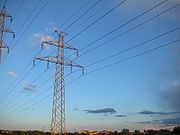From Wikipedia, the free encyclopedia
Electric power transmission, a process in the delivery of electricity to consumers, is the bulk transfer of electrical power. Typically, power transmission is between the power plant and a substation near a populated area. Electricity distribution is the delivery from the substation to the consumers. Electric power transmission allows distant energy sources (such as hydroelectric power plants) to be connected to consumers in population centers, and may allow exploitation of low-grade fuel resources that would otherwise be too costly to transport to generating facilities. Due to the large amount of power involved, transmission normally takes place at high voltage (110 kV or above). Electricity is usually transmitted over long distance through overhead power transmission lines. Underground power transmission is used only in densely populated areas because of its high cost of installation and maintenance, and because the high reactive power produces large charging currents and difficulties in voltage management.[citation needed]
A power transmission system is sometimes referred to colloquially as a "grid"; however, for reasons of economy, the network is not a mathematicalgrid. Redundant paths and lines are provided so that power can be routed from any power plant to any load center, through a variety of routes, based on the economics of the transmission path and the cost of power. Much analysis is done by transmission companies to determine the maximum reliable capacity of each line, which, due to system stability considerations, may be less than the physical or thermal limit of the line. Deregulation of electricity companies in many countries has led to renewed interest in reliable economic design of transmission networks. However, in some places the gaming of a deregulated energy system has led to disaster, such as that which occurred during the California electricity crisis of 2000 and 2001.[citation needed]
Contents[hide] |
Losses
Transmitting electricity at high voltage reduces the fraction of energy lost to Joule heating. For a given amount of power, a higher voltage reduces the current and thus the resistive losses in the conductor. For example, raising the voltage by a factor of 10 reduces the current by a corresponding factor of 10 and therefore the  losses by a factor of 100, provided the same sized conductors are used in both cases. Even if the conductor size is reduced x10 to match the lower current the
losses by a factor of 100, provided the same sized conductors are used in both cases. Even if the conductor size is reduced x10 to match the lower current the  losses are still reduced x10. Long distance transmission is typically done with overhead lines at voltages of 115 to 1,200 kV. However, at extremely high voltages, more than 2,000 kV between conductor and ground, corona discharge losses are so large that they can offset the lower resistance loss in the line conductors.
losses are still reduced x10. Long distance transmission is typically done with overhead lines at voltages of 115 to 1,200 kV. However, at extremely high voltages, more than 2,000 kV between conductor and ground, corona discharge losses are so large that they can offset the lower resistance loss in the line conductors.
Transmission and distribution losses in the USA were estimated at 7.2% in 1995 [2], and in the UK at 7.4% in 1998. [3]










No comments:
Post a Comment